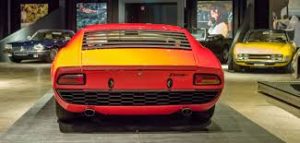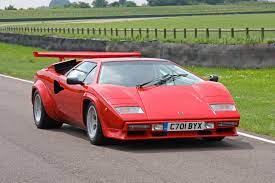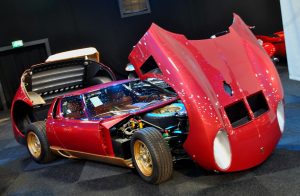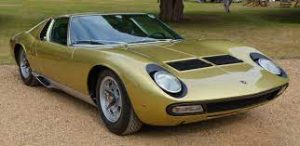The Lamborghini Miura; one of motoring’s finest accomplishments. Its exquisite and beautiful legacy is one that will forever remain untarnished, and it is undoubtedly one of the most legendary sports cars of all-time.
It gets it name from a breed of Spanish fighting bull, which should certainly say a great deal about its character. The wild Miura possesses a monstrous 3929 cc Lamborghini V12 engine which is mounted transversely in the rear, and is more than capable of producing an astonishing 430-horsepower. For a car first built in 1966, this is quite simply incredible. 764 were built, demonstrating the rarity of this classic. The Miura was instantly a cult classic, and its layout was such a phenomenon that is has since become the standard for high-performance cars in the sports and super sub-categories. At the time of its release, the Miura held the crown for being the fastest road production car.

The formula was nigh-on unheard of; a beautiful-looking car with the astonishing performance to match? Lamborghini had effectively perfected the supercar concept; expertly combining speed, handling and control, and doing this all in one of the best-looking cars the world had ever seen.
Initially, the Lamborghini Miura was conceived by Lamborghini’s engineering team, who had designed the car in their own spare time. This was going against the wishes of Ferrucio Lamborghini, the company’s founder, who made it abundantly clear that he favoured powerful yet refined grand touring cars, rather than bold, bashful race cars produced by the likes of Ferrari, their local rivals.
The Miura’s chassis was a rolling one, and it was proudly presented at the 1965 Turin Auto Show, whilst its sibling prototype debuted a year later, at the 1966 Geneva Motor Show. The reception it received from showgoers, the press, and enthusiasts alike was astounding. Marcello Gandini, the chief designer, received instantaneous applause and recognition for the Miura’s crisp, sleek style as well as the revolution that was its mid-engine design.
With its success came exponential growth for Lamborghini. The Miura swiftly became their flagship car, and it would go on to receive periodic updates and upgrades all the way up until 1973, when it came out of production. After the Miura came the Countach – a striking-looking car to say the least. However, it wasn’t without its flaws. Unlike the Miura, the Countach received criticism for its poor handling, its overly-wide body and its more sharp, angular design.

In many eyes the Countach is a thing of beauty, and is quintessentially Lamborghini, however, its far-too-lengthy list of flaws ruined its reputation. It was impractical beyond words, with a terribly designed cabin, an unaerodynamic structure and, as mentioned before, quite awful handling. Following something as staggering as the Miura with something as defective as the Countach marked the beginning of turbulent financial times for the company, and so the Countach will forever be earmarked as a bad omen, whilst the Miura is often hailed as the last ‘classic’ Lamborghini, and holds the title of being the ‘original supercar.’
The Miura laid the foundation for what we now know as the modern supercar, and even the most modern hypercars. It was motoring innovation at its finest; the epitome of brilliance, and its pièce de resistance was the transverse, mid-mounted V12 engine. Its body was low, sleek and sweeping, running all the way from the shark nose to the tail in a beautifully crafted ribbon of metal. Its windscreen was large and curved, and it rose to the roof which was a mere 1050-millimetres from the ground. The Miura’s low-profile allowed it to ghost over tarmac in a stunning blend of grace and power. Louvres covered the engine, keeping rainwater out and retaining excellent rear visibility, and air intakes were drawn in from rocker panels which cooled the rear brakes. For lighter weight, the front hood and rear engine cover were constructed of aluminium, and these were clamshell-designed and so allowed for easier access to the vehicle’s mechanical components.

The Miura simply is the supercar. The first and foremost, and still one of the best. Exhaustive effort went in to the Miura, ensuring its performance was the best it could possibly be. Even the smallest details were considered. The twin-circular headlights were sourced from the Fiat 850 Spider, and they were made flush with the nose to reduce drag. Surrounding the lights were the Miura’s signature ‘eyelashes,’ which actually served as air intakes for the front brakes. These small, minute intricacies are what makes the Miura so great; the sheer level of attention-to-detail in every single aspect. In every mechanical component, every brake disc and every body part, extensive hours of research and development were poured in by the engineering team, creating what is close to being the perfect supercar.

Our two model equivalents are brilliant representations of the real-life counterpart. They both come complete with a striking red livery, with the P400S being adorned with a gold trim, and the SVJ sporting a black trim and spoiler.
The Miura has undoubtedly cemented its place in the motoring hall-of-fame, and it’s likely that it won’t ever be surpassed in terms of innovation. Many renditions have followed, all garnering a highly alluring status, but the original will always be the best, as it laid the groundwork for generations to come. Supercars strive to be considered in the same bracket as the Miura, and very few manage to achieve that, even now. That statement alone shows the Miura’s timeless brilliance.




Follow us to keep up-to-date using our social networks
Enter your email address to sign up to our newsletter to keep up-to-date.




